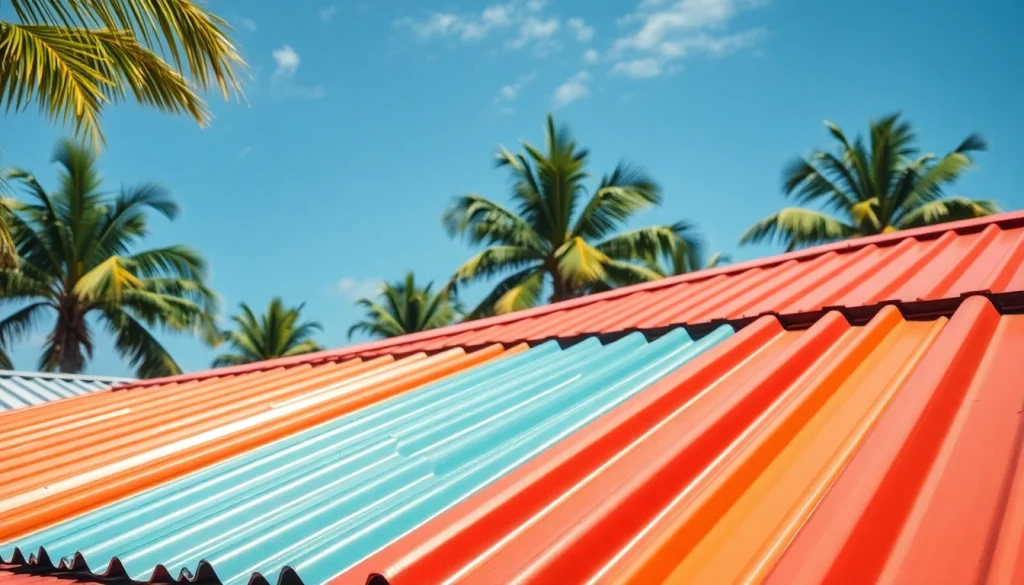Understanding Florida Metal Roofing: An Overview
Florida’s unique climate demands roofing materials that can withstand intense sunlight, high humidity, and extreme weather conditions such as hurricanes. Among various roofing materials, florida metal roofing has risen to prominence due to its durability, energy efficiency, and aesthetic appeal. This comprehensive guide delves into the intricacies of metal roofing in the Sunshine State, providing insights into its advantages, types, installation practices, and considerations regarding costs.
1.1 What is Metal Roofing?
Metal roofing refers to roofing systems made primarily from metal materials, which can include aluminum, steel, copper, and zinc. These materials are renowned for their longevity, lightweight nature, and strength, as well as their ability to be fashioned into a variety of designs and finishes. Metal roofing can range from panels and shingles to tiles, accommodating a broad spectrum of architectural styles.
1.2 Benefits of Metal Roofing in Florida
Several benefits make metal roofing an attractive option for Florida residents:
- Durability: Metal roofs can last 40 to 70 years, significantly outperforming traditional materials like asphalt shingles, which typically last only 20 to 30 years.
- Weather Resistance: Designed to withstand hurricanes and heavy rains, metal roofs have a high wind rating and can resist impact from falling branches or hail.
- Energy Efficiency: Metal reflects solar heat, helping to reduce cooling costs by up to 25%, making it ideal for Florida’s hot climate.
- Environmentally Friendly: Many metal roofs are made from recycled materials and are recyclable themselves, reducing environmental impact.
- Aesthetic Appeal: Available in various styles and colors, metal roofing can enhance the curb appeal of any home.
1.3 Common Myths About Metal Roofing
Despite its advantages, several myths surround metal roofing:
- Metal roofs are noisy: Proper installation and insulation can mitigate noise, making them no noisier than other roofing materials during storms.
- Metal roofs rust easily: Most metal roofing in Florida is made from aluminum or treated steel, both of which resist rusting.
- Metal roofs attract lightning: There is no evidence to support this claim; metal roofs can be safer during a lightning strike as they disperse electricity.
The Types of Florida Metal Roofing
2.1 Popular Metal Roof Materials
Choosing the right material is crucial for maximizing the benefits of metal roofing. Here are some prevalent options:
- Aluminum: Lightweight and resistant to corrosion, aluminum is an excellent choice for coastal areas where salt exposure is high.
- Steel: Steel roofing can be galvanized or galvalume, both offering impressive durability and resistance to the elements. Steel is often more cost-effective than aluminum.
- Copper: Known for its aesthetic appeal and longevity, copper roofs can last over 100 years but come at a higher price point.
- Metal Tiles: These panels replicate traditional roofing styles and can be crafted from various metals, providing versatility in design.
2.2 Comparing Metal Roof Styles
Metal roofing comes in various styles, including:
- Standing Seam: Panels that interlock at the seams, providing a sleek look and enhancing water resistance.
- Corrugated Panels: Known for their ribbed design, these panels are lightweight and easy to install, making them cost-effective.
- Metal Shingles: These imitate the appearance of traditional shingles while delivering the benefits of metal.
2.3 Choosing the Right Metal Roof for Your Home
When choosing a metal roof, consider factors such as:
- Local Climate: Coastal regions benefit from aluminum, while inland areas can leverage the cost-effectiveness of steel.
- Home Design: Ensure the metal style and color complement your home’s architecture.
- Budget: Factor in both material costs and installation when setting your budget.
Installation Practices for Metal Roofing
3.1 Essential Tools and Equipment
To install a metal roof successfully, gather these essential tools:
- Power Drill
- Metal Cutting Shears
- Measuring Tape
- Safety Gear (gloves, goggles, harnesses)
- Level and Chalk Line
3.2 Step-by-Step Installation Guide
Here’s a brief overview of the installation process:
- Preparation: Inspect the existing roof and make necessary repairs.
- Installation of Underlayment: Install a moisture barrier to protect against leaks.
- Install Flashing: Flashing should be placed around vents and chimneys to redirect water.
- Lay Down Panels: Begin at the eaves and work up, ensuring panels are secured according to manufacturer specifications.
- Finish with Trim: Install trim pieces to give the roof a polished look.
3.3 Hiring a Professional vs. DIY Installation
While DIY installation can save costs, hiring a professional is recommended for complex roof designs or for those without roofing experience. Professionals ensure proper installation, which can extend the life of your metal roof and prevent common issues.
Maintenance Tips for Florida Metal Roofs
4.1 Routine Maintenance Practices
Regular maintenance extends the life of metal roofing:
- Routine Inspections: Conduct inspections twice a year for signs of wear or damage.
- Cleaning: Keep the roof clean from debris, leaves, and branches to prevent moisture buildup.
- Gutter Maintenance: Ensure gutters and downspouts are clear to allow proper drainage.
4.2 Handling Common Issues
If you encounter issues such as rust or leaks, address them promptly. Use touch-up paint for scratches and sealants for minor leaks. If damage is extensive, consult a professional to avoid further complications.
4.3 Ensuring Longevity and Performance
To maximize the lifespan of your metal roof:
- Inspect regularly for any loose fasteners or panels.
- Ensure that any penetrations (like vents) are sealed correctly.
- Consider painting your roof every 10-15 years to maintain its appearance and resistance to UV damage.
Cost Considerations for Florida Metal Roofing
5.1 Average Costs of Metal Roofing
Metal roofing costs vary widely depending on materials, labor, and complexity, but on average, homeowners can expect to pay between $18,000 to $45,000 for a standard-sized home (approximately 2,000 square feet).
5.2 Factors Affecting Metal Roof Pricing
Key factors influencing the cost include:
- Material Choice: Aluminum tends to be more expensive than steel, while copper is typically the highest.
- Roof Design: Complex roofs with many angles or features will require more labor and materials.
- Installation Difficulty: Roofs that require extensive prep work or have limited access will incur higher labor costs.
5.3 Return on Investment for Metal Roofs
Investing in a metal roof can yield a significant return. With proper maintenance, homeowners can approach up to a 90% return on investment when installed correctly, considering the long-term savings on repairs, heating, and cooling.


